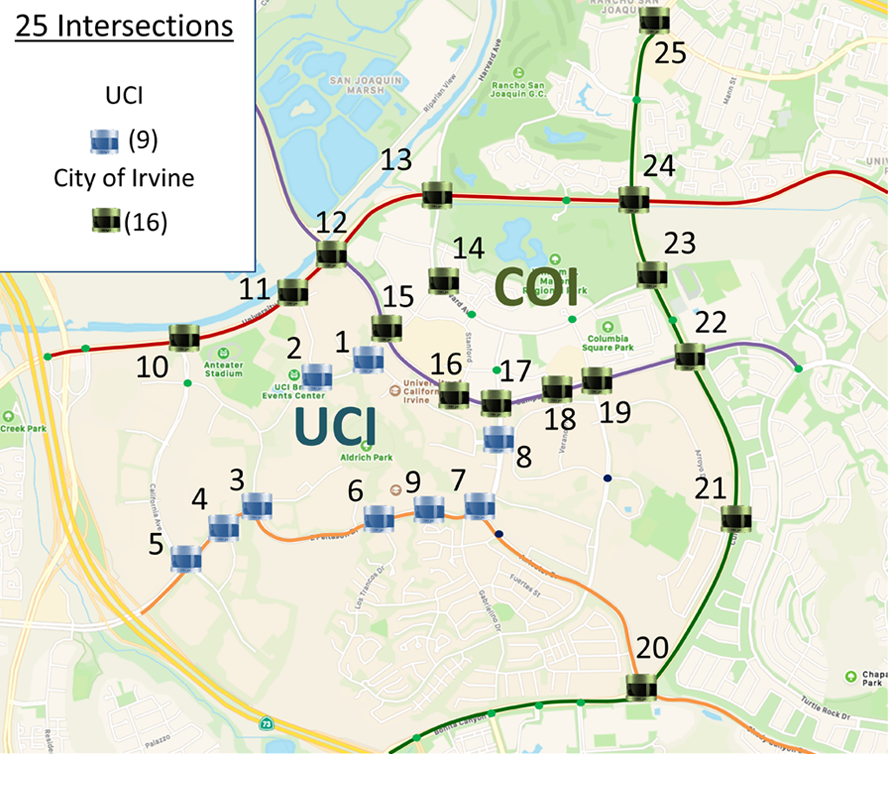The HORIBA Institute for Mobility and Connectivity (HIMaC) at the University of California (UCI) has been awarded a research demonstration pilot by the DOE with the goal to establish and utilize a Public Road Network Platform comprised of 25-intersections in the City of Irvine designed to: (1) assess a novel energy efficient AI-based mobility monitoring system in a real-world transportation application; (2) provide needed insight into key use cases of AI-based systems to meet DOE goals including mobility energy productivity (MEP) and vehicle energy efficiency; (3) quantify system-level impact of an AI-based system technology at multiple scales while demonstrating at least a 15% improvement in energy efficiency; and (4) provide data and results to National Laboratories, Energy Efficient Mobility Systems (EEMS) researchers, and the Clean Cities/Technology Integration network.
To accomplish this goal, seven objectives will be met: (1) outfit three vehicle fleets and the Public Road Network Platform; (2) establish a simulation of the Network at the UCI Simulation Laboratory Platform and at ANL; (3) characterize the vehicles using the UCI Controlled Physical Laboratory Platform and at ANL; (4) establish and test the use cases; (5) assess the technology and its impact on project goals; (6) format and provide data and results to the SMART Mobility National Lab Consortium through the Livewire Data Platform, EEMS researchers, and the Clean Cities/Technology Integration network; and (7) through outreach with Saddleback Community College and Southern California Association of Governments, communicate the results to the broader transportation community and inspire a needed workforce.
The approach is to deploy an emerging "AI-based" CDA technology comprised of an automated mobility monitoring lidar mounted throughout an intersection network and coupled with data analytics with the goal to generate the portfolio of backbone traffic data needed to meet the energy and traffic efficiency, safety, and economic goals to which cities aspire. Distinct advantages, among many, of the AI-based system include one unit per intersection and preclusion of privacy constraints. Three fleets of ten vehicles each with distinct modes of operation (independent driving, shared-use driving, and autonomous) will be utilized within the public infrastructure.
The HIMaC-led demonstration pilot encompasses a multi-disciplinary partnership comprised of the UCI Institute of Transportation Studies (ITS) with its 47 years of interdisciplinary research on contemporary transportation issues; the Argonne National Laboratory (ANL) and its Center for Transportation Research (CTR) that offers multidisciplinary expertise, tools, and facilities to meet complex and continually evolving mobility challenges; the City of Irvine, the nation's largest planned community with a prominent multi-modal public transportation system; Velodyne Lidar who, in collaboration with Bluecity Technology, is providing smart, powerful lidar solutions for autonomous vehicles and driver assistance; and key support from the Southern California Association of Governments (the Southern California's Clean Cities Coalition representative), Saddleback Community College, Pony.ai; and Hyundai Mobis.
Project Summary
Develop a Public Road Network Platform of AI-Systems to test, develop, and collect data on advanced driving technologies.
Using an AI-System backbone at signalized intersections, achieve a 15% energy efficiency improvement:
Using an AI-System backbone at signalized intersections, achieve a 15% energy efficiency improvement:
- AI-System monitors intersection dynamics and develops traffic analytics
- Controller calculates optimal vehicle speed and traffic signal timing and sends messages to vehicles
- Experiments in three phases:
- Simulation
- Vehicle-in-the-loop using vehicle dynamometer
- On-road deployment with three vehicle fleets

